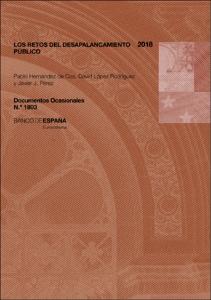Los retos del desapalancamiento público
Autor
Fecha de publicación
9-mar-2018
Descripción física
40 p. : gráficos, tablas
Resumen
Los niveles de deuda pública sobre el PIB en una mayoría de países de la UEM, incluida España, se encuentran en niveles muy elevados de acuerdo con los registros históricos disponibles. La literatura económica es concluyente en señalar que el mantenimiento de ratios de deuda pública muy elevadas durante períodos temporales prolongados puede resultar perjudicial para el crecimiento económico y suponer una fuente de vulnerabilidad para la economía, además de reducir la capacidad estabilizadora del presupuesto público. En este contexto, las reformas del Pacto de Estabilidad y Crecimiento europeo y de la Ley de Estabilidad Presupuestaria española acometidas durante la reciente crisis reforzaron el papel de esta variable en el marco presupuestario. Las simulaciones realizadas en el presente trabajo muestran que, bajo determinados supuestos macroeconómicos, un proceso de desapalancamiento público como el exigido por el Pacto de Estabilidad para el caso de la economía española exigirá un esfuerzo de consolidación fiscal todavía significativo y que debe perdurar en el tiempo
The government debt-to-GDP ratios in the majority of euro area economies, including Spain, are at very high levels according to the available historical records. Economic research is conclusive in pointing out that bearing high levels of public debt ratios for an extended period of time can be damaging for economic growth. The economic literature also concludes that sustained high debt ratios create a source of vulnerability for the economy, besides of lessening the stabilization capacity of the public budget. In this context, the reform of both the European Stability Pact and the Spanish Stability Law during the recent crisis strengthened the role of public debt in the budgetary framework. The simulations carried out in this paper show that, under plausible macroeconomic assumptions, the public deleveraging process required by the Sustainability Pact for Spain will still imply a significant fiscal consolidation effort that has to be sustained over time
The government debt-to-GDP ratios in the majority of euro area economies, including Spain, are at very high levels according to the available historical records. Economic research is conclusive in pointing out that bearing high levels of public debt ratios for an extended period of time can be damaging for economic growth. The economic literature also concludes that sustained high debt ratios create a source of vulnerability for the economy, besides of lessening the stabilization capacity of the public budget. In this context, the reform of both the European Stability Pact and the Spanish Stability Law during the recent crisis strengthened the role of public debt in the budgetary framework. The simulations carried out in this paper show that, under plausible macroeconomic assumptions, the public deleveraging process required by the Sustainability Pact for Spain will still imply a significant fiscal consolidation effort that has to be sustained over time
Publicado en
Documentos Ocasionales / Banco de España, 1803
Otras versiones
Materias
Deuda pública; Consolidación fiscal; Estabilización macroeconómica; Public debt; Fiscal consolidation; Macroeconomic stabilisation; Déficit y deuda públicos; Política monetaria; Política fiscal; España
Aparece en las colecciones:












